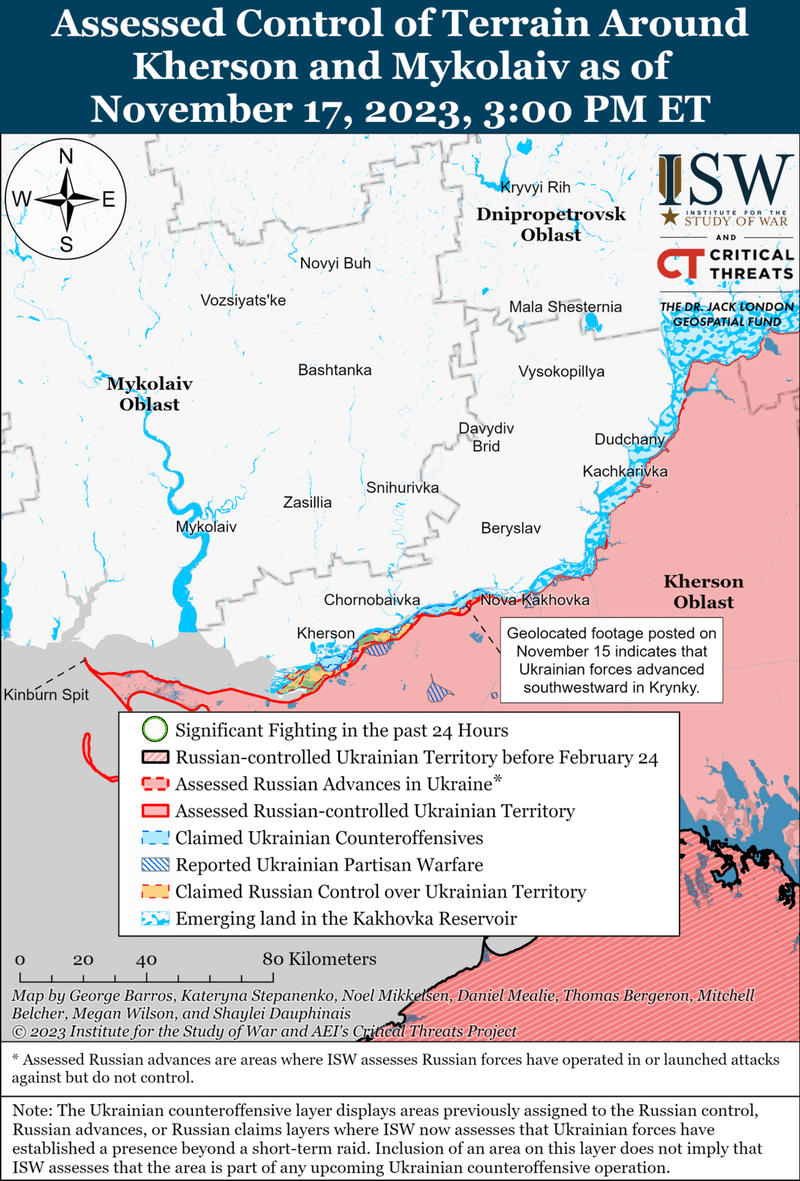
【抄訳】ISW ロシアによる攻勢戦役評価 1915 ET 17.11.2023 “ヘルソン東岸に「橋頭堡」確立とウクライナが発表”
本記事は、戦争研究所(ISW)の2023年11月17日付ウクライナ情勢評価報告の一部を抜粋引用したうえで、その箇所を日本語に翻訳したものである。
(記事サムネイル画像はウクライナ軍参謀本部のFacebook投稿写真を使用した)
ウクライナ軍のヘルソン“橋頭堡”発表
報告書原文抜粋(英文)
Ukrainian officials stated that Ukrainian forces have established bridgeheads on the east (left) bank of Kherson Oblast and are conducting ground operations aimed at pushing Russian forces out of artillery range of the west (right) bank of the Dnipro River. The Ukrainian Marine Corps Command and the Ukrainian General Staff stated on November 17 that Ukrainian marines have secured several “bridgeheads” on the east bank following successful actions and are conducting actions to expand these positions. US military doctrine defines a bridgehead as “an area on the enemy’s side of the water obstacle that is large enough to accommodate the majority of the crossing force, has adequate terrain to permit defense of the crossing sites, provides security to crossing forces from enemy direct fire, and provides a base for continuing the attack.” The doctrinal definition of a bridgehead does not stipulate a certain size for the crossing force, the extent of the secured positions, or the ability to transfer and operate heavy military equipment from those positions. The necessary size of a bridgehead depends on the operations it is meant to support, and the official Ukrainian acknowledgment of these positions as bridgeheads indicates that the Ukrainian command assesses that these positions are sufficient for continuing ground operations on the east bank.
The Ukrainian General Staff stated that one of the main operational objectives for Ukrainian ground operations on the east bank is to prevent Russian shelling of Ukrainian civilians on the west bank of Kherson Oblast, particularly near Kherson City. The 152mm tube artillery systems that Russian forces widely operate in Ukraine have an approximate range of 25km, although Russian forces are unlikely to deploy these systems to immediate frontline areas due to the threat of Ukrainian counterbattery fire. The Ukrainian General Staff reported that Ukrainian forces on the east bank are conducting diversionary actions, raids, and reconnaissance and are particularly surveilling Russian positions for intelligence on Russian logistics and ammunition concentrations.
日本語訳
ウクライナ軍がヘルソン東岸(左岸)の複数箇所で橋頭堡をすでに築き、ドニプロ川西岸(右岸)を砲撃できる範囲からロシア軍を押し出すことを目的とした地上作戦を、現在遂行していることを、ウクライナ側当局者は発表した。ウクライナ海兵隊司令部及びウクライナ軍参謀本部の11月17日付発表によると、ウクライナ海兵隊は、成果をあげた一連の行動に続き、東岸に複数の「橋頭堡」を確保したとのことで、また、海兵隊はこれらの展開拠点を拡張するための行動をとっている最中であるとのことだ。米国の軍事ドクトリンにおける橋頭堡の定義は、「水域障害地域の敵側に位置するエリアで、上陸戦力の大半を収容できるだけの広さを有するのみならず、上陸戦力を防御できる適切な地形も有するエリアであり、また、敵直接射撃からの防護を上陸戦力に与え、今後続く攻撃のための拠点を与えるエリアである」というものだ。この橋頭堡に関するドクトリン上の定義は、上陸戦力の具体的な規模、確保された地域の広さ、または、これらの拠点から重軍事装備を動かして運用する能力について、規定していない。必要とされる橋頭堡の規模は、その橋頭堡が支援する予定の作戦次第で決まる。そして、ウクライナ側が東岸の拠点を橋頭堡として公式に認めたことは、ウクライナ軍統帥部がこれらの拠点を、東岸における今後の地上作戦にとって十分なものと評価していることを示している。
ウクライナ参謀本部の発表によれば、東岸におけるウクライナ軍の主たる作戦目標の一つは、ロシア軍がヘルソン州西岸の、特にヘルソン市周辺のウクライナ民間人を砲撃できないようにすることにある。ロシア軍がウクライナで多く運用している152mm野戦砲システムはおよそ25kmの射程をもっているが、ロシア軍がこの種の火砲を最前線のすぐ側に配置している可能性は低い。なぜなら、ウクライナ側の対砲兵射撃の脅威があるからだ。ウクライナ軍参謀本部の報告によると、東岸に展開するウクライナ軍は、欺瞞行動、小規模襲撃、偵察活動を遂行している。特にロシア軍展開地点の捜索を重視して行っており、その目的はロシア軍兵站網及び弾薬集積箇所に関する情報を集めることにあるとのことだ。

(戦争研究所)
ヘルソン東岸のロシア軍防御態勢
報告書原文抜粋(英文)
Russian forces appear to be applying lessons learned from attempts to man Russian multilayered defenses in western Zaporizhia Oblast during the Ukrainian counteroffensive to current Russian defensive operations in Kherson Oblast. The Ukrainian General Staff acknowledged that Russian forces have a “fairly serious” line of fortifications in Kherson Oblast. A Ukrainian soldier operating on the left (east) bank of Kherson Oblast characterized Russian defensive positions as “elaborate dugouts that [Russian forces] constructed over months” in an interview with the Wall Street Journal (WSJ) published on November 15. The WSJ also reported that Russian forces heavily mined the area around Krynky (30km northeast of Kherson City and 2km from the Dnipro River), where Ukrainian forces currently maintain positions. Ukrainian military observer Kostyantyn Mashovets noted that Russian forces are not deploying their forces in a “pillar formation” at the immediate frontline on the east bank, likely in an effort to protect concentrations of Russian forces from Ukrainian artillery fire and drone strikes. Mashovets claimed on November 12 that the Russian command in the Kherson direction has refused to commit additional forces of the 70th Motorized Rifle Division (of the newly formed 18th Combined Arms Army) and 7th Air Assault (VDV) Division beyond elements of single regiments and battalions to the frontline, opting instead to maintain the remainder of these formations in near rear areas and secondary echelons of defense.
This tactical deployment of forces in Kherson is reminiscent of changes that Russian forces made to Russian tactical defensive deployments in western Zaporizhia Oblast. ISW observed Russian forces concentrating personnel along the defensive layer closest to Ukrainian offensive operations at the start of the Ukrainian counteroffensive in western Zaporizhia Oblast. ISW observed a shift in Russian defensive operations as Ukrainian forces began penetrating Russian defensive layers in mid-September, wherein Russian forces shifted personnel away from manning immediate frontline defensive positions in order to man defensive layers further from the frontline from which more combat effective forces would counterattack. Russian forces have not constructed extensive visible defensive fortifications similar to those that Russian forces established in western Zaporizhia Oblast prior to the start of the Ukrainian counteroffensive and appear to have opted for more discrete fortifications set further from the frontline. The discrete fortifications located away from the frontline in Kherson Oblast will likely only be fully effective if they remain concealed, however. Fall and winter weather conditions may reveal some concealed positions as foliage and natural ground cover die.
日本語訳
ウクライナ軍が反転攻勢を進める間に、ロシア軍はザポリージャ州西部での多層防御陣地網への兵力配置に関する試行錯誤から教訓を得ており、その教訓をロシア軍は目下のヘルソン州防衛作戦に適応しようとしているようにみえる。ロシア軍がヘルソン州において「かなり本格的な」強化防御陣地を有していることを、ウクライナ軍参謀本部は認識している。ヘルソン州左岸(東岸)で任務についているウクライナ軍兵士の一人は、ロシア軍防御陣地の特徴を「(ロシア軍が)何カ月もの間、構築してきた入念な屋根つきの塹壕」と、11月15日付ウォール・ストリート・ジャーナル(WSJ)のインタビュー記事のなかで描写している。WSJ紙はまた、ロシア軍がクリンキ(ヘルソン市北東30km、ドニプロ川から内陸に2km)周辺の場所に、地雷を重厚に埋設していると報じた。なお、このクリンキという集落内に、ウクライナ軍は現在、拠点を保持している。ウクライナ人軍事評論家のコンスタンティン・マショヴェツの指摘によると、ロシア軍は東岸の最前線のすぐ側に「中軸となる部隊」からの戦力を送っていないとのことで、集結したロシア軍をウクライナ側火砲及びドローン攻撃から防護することを意図している可能性が高いとのことだ。11月12日のマショヴェツの主張によると、ヘルソン方面ロシア軍司令部は、第70自動車化狙撃師団(新編の第18諸兵科連合軍に属する)及び第7空中強襲師団(第7VDV師団)からの戦力を、1個連隊・1個大隊の規模を超えて、最前線に追加投入することを拒否しているとのことで、そうする代わりに、これらの戦力の内、前線に投入されていない残りを、ロシア軍司令部は後方地域付近や防衛網第2線陣地に保持しておくほうを選んでいるという。
ヘルソンにおける戦術レベルの戦力展開は、ロシア軍がザポリージャ州西部防衛で変化させていった戦術レベルの戦力配置を彷彿とさせる。ザポリージャ州西部でのウクライナ軍反転攻勢開始時、ロシア軍がウクライナ側攻勢行動地点に最も近い防御層に兵力を集中させていたことを、ISWは観測している。9月中頃にウクライナ軍がロシア側防衛層内へと進入し始めた頃、ロシア軍の防衛任務遂行に変化が生じたこともISWは観測している。その時点でロシア軍は、最前線に兵力を充足させる方法から、最前線から離れた防衛層に兵力を充足させるために、兵力配置の転換を行った。そして、より戦闘能力の高い部隊があれば、最前線より後方にある陣地から反撃を行った。ウクライナ軍反攻に先立ってロシア軍が構築したザポリージャ州西部の防御陣地と同じような、広範囲に視認可能な防御陣地施設をロシア軍は構築しておらず、前線から離れた地点に、もっと個々に独立した防御陣地施設をつくるほうをロシア軍は選択している模様だ。だが、ヘルソン州の前線から離れたところに位置する個々独立した防御施設は、それらが隠蔽されたままである場合においてのみ、完全に効果を発揮していく可能性が高い。秋と冬の気象条件は、樹木の葉等の地上の自然隠蔽物をなくしてしまい、隠蔽された陣地群の一部を暴露させてしまう可能性がある。
東岸ロシア軍の損耗状況
報告書原文抜粋(英文)
Ukrainian officials reported that Russian forces have suffered roughly a brigade’s worth of casualties since Ukrainian forces started ground operations on the east bank of Kherson Oblast on October 17, reportedly forcing Russian forces to transfer combat power from elsewhere in Ukraine to Kherson Oblast. The Ukrainian General Staff reported that Ukrainian forces have killed 1,216 Russian personnel and wounded 2,217 since starting “measures” on the east bank.[11] These manpower losses are roughly equivalent to a brigade’s worth of personnel, although these losses are likely spread out across the Russian formations and units operating in the Kherson direction. The Ukrainian General Staff also reported that Ukrainian forces have destroyed 24 Russian tanks, 48 armored combat vehicles, 89 artillery systems, 29 ammunition warehouses, and 14 aircraft since starting "measures” on the east bank. The Ukrainian General Staff reported that Russian forces have transferred unspecified units from other unspecified sectors of the front to Kherson Oblast due to these losses. ISW previously assessed that the Russian military command will likely struggle to redeploy combat-effective reinforcements at scale to respond to ongoing Ukrainian operations in Kherson Oblast while conducting defensive operations in western Zaporizhia Oblast and sustaining other offensive efforts in eastern Ukraine. The scale of Russian reinforcements required, however, depends heavily on how much effort Ukrainian forces put into the Kherson direction and how much progress they make.
日本語訳
10月17日にウクライナ軍がヘルソン州東岸での地上作戦を始めて以降、ロシア軍が1個旅団相当の死傷者を出しているとウクライナ当局者は報告しており、ロシア軍はウクライナの他の地区からヘルソン州へと、戦力を移さざるを得なくなっている模様だ。ウクライナ軍参謀本部の報告によると、東岸での「行動計画」を始めて以来、ウクライナ軍は1,216人のロシア兵を戦死させ、2,217人を負傷させたとのことだ。この人的損耗はおよそ1個旅団に相当するが、この損失はヘルソン方面で行動するロシア軍の各種部隊全体の合計である可能性が高い。ウクライナ軍参謀本部はまた、ウクライナ軍がロシア軍戦車24両、装甲戦闘車両48両、火砲89門、弾薬保管施設29箇所、航空機14機を、東岸での「行動計画」開始以降に破壊したと報告した。このような損失の結果、ロシア軍が戦線上のどこかほかの地区からヘルソン州に、何がしかの部隊を移送していることを、ウクライナ軍参謀本部は伝えている。ロシア軍がザポリージャ州西部で防衛任務を遂行しつつ、ウクライナ東部でそれとは別の攻勢任務遂行を続けているなか、ヘルソン州で目下続くウクライナ軍作戦に対応するために、有効な戦力をもつ増援戦力を、どこかからか大規模に配置転換することに、ロシア軍統帥部が苦慮することになる可能性は高いというのが、ISWが以前示した評価である。だが一方で、必要とされるロシア軍増援の規模は、ウクライナ軍がヘルソン方面にどれほど注力するのか、また、ウクライナ軍がどれほどの進捗を示すことができるのかに、大きく左右される。
この記事が気に入ったらサポートをしてみませんか?
